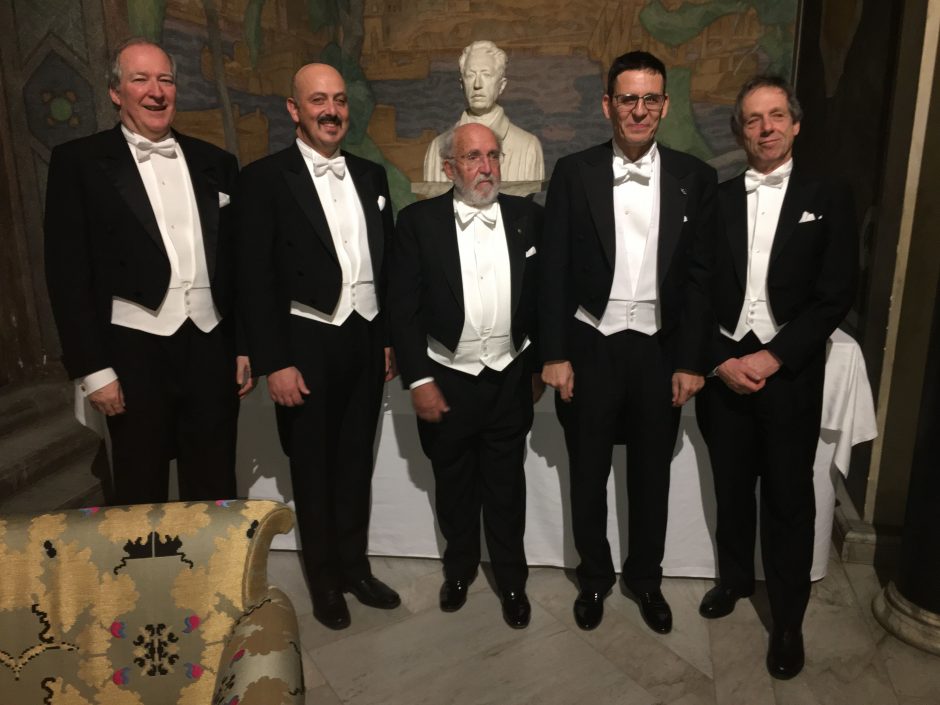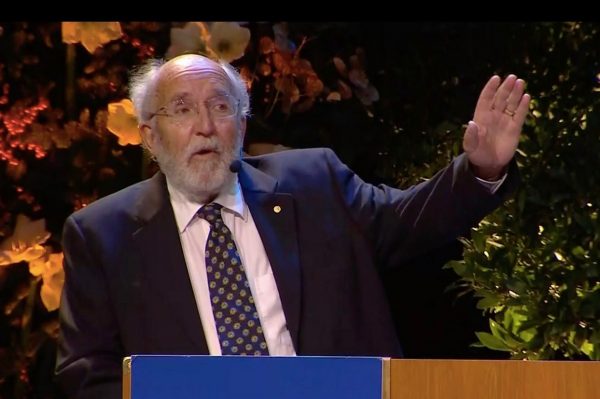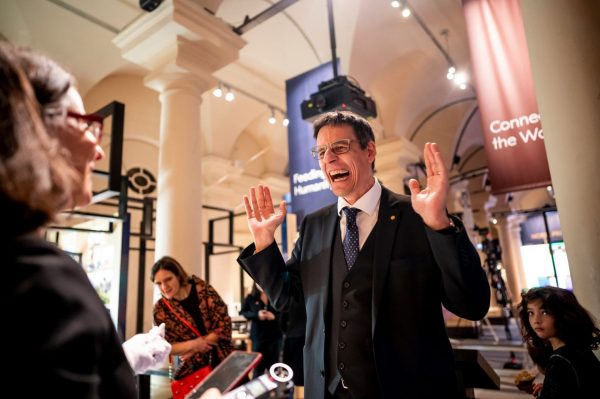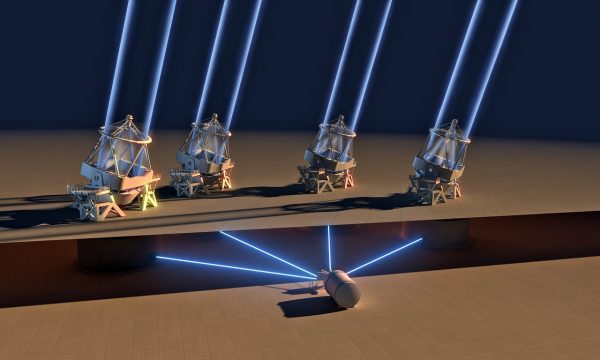They changed our conception of the world, no less !

This year’s Laureates have transformed our ideas about the cosmos. While James Peebles’ theoretical discoveries contributed to our understanding of how the universe evolved after the Big Bang, Michel Mayor and Didier Queloz explored our cosmic neighbourhoods on the hunt for unknown planets. Their discoveries have forever changed our con-ceptions of the world.
With these strong words, the Nobel Prize committee has recognized their unique contributions to science and knowledge. Changing our conceptions of the world, nothing less. The dream of all scientists. Not just leaving footprints along a well-travelled path but opening a new trail from which new perspectives can emerge. They have done it and have been recognized for it. Congratulations.

Michel Mayor during his Nobel lecture in Stockholm.
For someone working in planetary sciences, the discovery by Michel Mayor and Didier Queloz in 1995 was nothing else than a revolution. To measure its impact, it is necessary to remember that at the time only the planets in our solar system were known. Its characteristic architecture, small rocky planets close to the sun and giant gaseous planets further away, was considered as an unquestionable generic feature of all planetary systems. The discovery by the two Nobel Laureates shatters it all! A giant planet (roughly half the mass of Jupiter) orbiting its star (51 Pegasi) at a distance seven times smaller than Mercury is to our sun. Game over! We knew immediately that something was wrong, no room for arguing. The discovery of a single object was enough to send us all back to the drawing board!

Didier Queloz in the museum of Stockholm.
An obvious question comes to mind: Why did it take so long for detecting the first planet orbiting another star like the sun? The answer is easy: contrast and separation. Compared to the star they orbit, planets are extremely faint. Typically, the contrast ratio is of order 10-8 – 10-10 in the visible and 10-6 in the infrared. If we couple this huge contrast ratio with the fact that as seen from us, the separation between planet and star is very small (typically a fraction of an arc-second or even much less), it becomes obvious that “seeing” planets is an enormous challenge even for our most modern telescopes and instruments. In fact, it is such a challenge that clever indirect methods have been used to detect planets while waiting for high-contrast high-resolution imaging to mature. While planets cannot be seen, the host star is clearly visible. With precise Doppler measurements, their small motions resulting from the gravitational pull of planet(s) in orbit (a dynamical effect) can be measured and a minimum mass for the planet determined. With ultra-precise measurements of the intensity of the light received from the star, the slight dimming resulting from a planet transiting in front of the star (a photometric effect) can be detected and the size of the planet determined. For planets measured with both techniques, mass and radius are known and therefore their mean density can be computed, a first step in the characterisation of exoplanets.
Michel Mayor was an astronomer initially interested in the kinematics of stars. The need for high precision data for developing dynamical models of galaxies and stellar clusters pushed him to consider the possibility of developing a more accurate method. In the seventies, he turned his attention towards a cross-correlation technique pioneered by Roger Griffin in the UK and imported it to Geneva Observatory. By the time, I started my PhD thesis under his supervision in 1979, his first spectrograph, named CORAVEL, could measure velocities of stars to a precision of the order of one km/s in just minutes. A first revolution in stellar dynamics but not quite enough for Michel Mayor and his drive for precision. A path towards an even better machine was beginning to take shape. With his graduate student Didier Queloz, who wrote a large part of the software driving the machine and carried out many observations at the telescope, and a group of dedicated engineers and technicians, the spectrograph ELODIE was built and installed on the 1.93 m telescope at the Observatoire de Haute-Provence in the South of France. This new generation machine was now capable of measuring velocities to a precision of order 10 m/s, a factor 100 improvement over the previous instrument. Achieving this precision is what made the detection of the first exoplanet possible in 1995.

CORAVEL, the first instrument of Michel Mayor installed on the 1m swiss telescope. (Credit: OHP)
As mentioned above, this single discovery had an enor-mous impact on the field and triggered an unprecedented explosion of activities. Groups in the US using a different technique (iodine cell) quickly became serious competitors but the Geneva group managed to develop their cross-correlation technique further by, among other, enclosing the spectrograph in a dedicated pressure- and temperature-stabilized vessel. A collaboration between the University of Geneva, the University of Bern, the Service d’Aéronomie and the Observatoire de Haute-Provence was established to build under the leadership of Michel Mayor the HARPS spectrograph for the European Southern Observatory (ESO) 3.6 m telescope in La Silla, Chile. Commissioned early 2000 and reaching a precision of better than 1 m/s, HARPS remained for over fifteen years the most powerful exoplanet finding machine based on radial velocity measurements. It definitively established Michel Mayor’s cross-correlation approach as the method of choice for precise radial velocity measurements. Earlier this year, the latest generation of spectrographs based on this technique was installed at the incoherent Cassegrain focus of the four 8.5 m ESO telescopes at Paranal Observatory in Chile. Built by a Consortium led by the University of Geneva and a new generation of instrument builders having been inoculated by Michel Mayor with the high-precision virus, the instrument now reaches 10 cm/s precision and can combine the light of all four telescopes, which corresponds to an effective light collecting area equivalent to a 16 m telescope. The world’s most stable spectrograph allowing measurements ten thousand times more precise than the original built forty years earlier. Forty years of painstakingly and consistently improving a measurement technique!

The 4 VLT united to concentrate the light on ESPRESSO
No, the discovery of Michel Mayor and Didier Queloz in 1995 was not due to chance, but to a clear vision of what technology was needed and to an incredible drive to get it done at a time when nearly everyone else thought it impossible. Despite this, the Swiss system (at both university and federal level) allowed Michel Mayor and Didier Queloz to obtain the support they needed to pursue their research. This constitutes a textbook example of the necessity to sustain curiosity driven research over significant periods of time especially in experimental areas where novel technology/instruments must be developed before new frontiers can be reached.
Today, nearly 25 years later and over 4000 additional dis-coveries, it is the diversity of planets and planetary systems that has become the rule. We now know that planets are ex-tremely common objects in the Universe, that they come in all sizes with the smaller ones being more numerous. Some are Earth-like and are located at distance to their star such that they are temperate opening the possibility to eventually search for life as we know it on Earth. To allow for this, the next generation infrastructures, technology, and measurement techniques are developed all over the world and will become available within the next decade or so. The discovery of the first exoplanet by Michel Mayor and Didier Queloz has not only changed our conception of the world, it also triggered an explosion of activities world-wide and opened the door to the search for life outside the solar system. A momentous achievement well deserving of the highest honour, the Nobel Prize.
Willy Benz, article published in the review of the “Schweizer Physikalische Gesellschaft”.
Categories: External Newsletter
